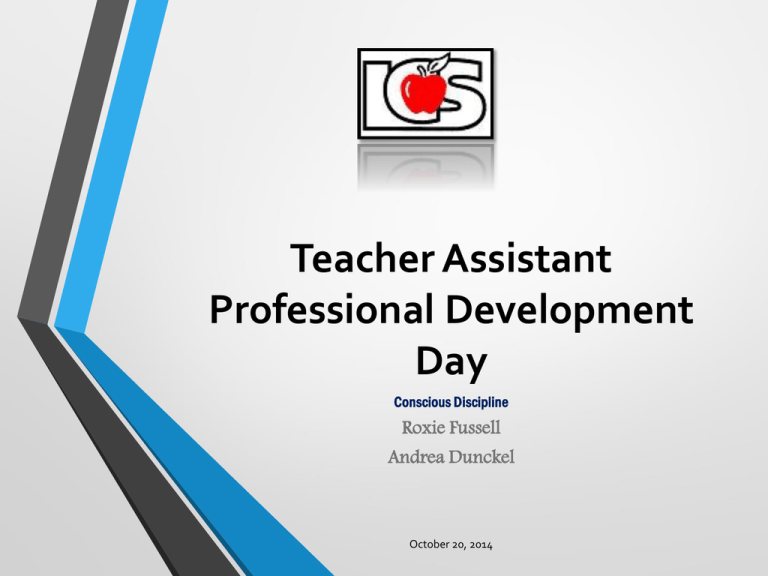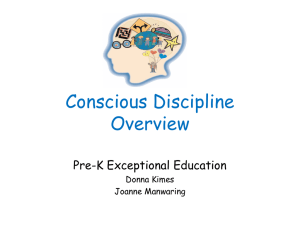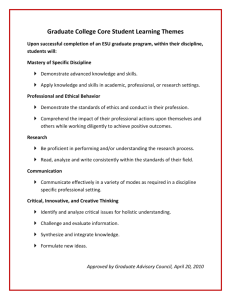
Teacher Assistant
Professional Development
Day
Conscious Discipline
Roxie Fussell
Andrea Dunckel
October 20, 2014
Common Board Configuration
Date: 10/20/2014
Bell Ringer: Complete Think Sheet #1. We will
discuss your answers later in the module.
Learning Goal:
Participants will be able to:
Define the difference between positive and
negative discipline.
Identify the importance of modeling
appropriate behavior and maintaining selfcontrol.
Demonstrate clear and assertive
communication strategies.
Understand that discipline is an opportunity to
teach, not punish.
Common Language: Conscious Discipline,
noticing, consequences, CPA, Safekeeper,
Class/School family, Brain Smart Start,
uploading, downloading, positive intent, I Love
You Rituals
Agenda: Gradual Release
I DO: Present the 10 Steps to Positive
Discipline.
WE DO: Practice breathing, practice
commands and practice I Love You Rituals.
YOU DO: Think sheets, uploading, positive
intent and practice Conscious Discipline in
your own life.
Objective: Participants will use Conscious Discipline
strategies and materials to improve social/emotional
learning and classroom management skills, which
leads to school-wide success.
Summarizing Activity: Commitment Activity
Essential Question: What steps can I take as a
Paraprofessional in a Pre-K classroom to change my
thinking from trying to control children with
manipulative strategies to learning how to maintain
self-control in order to teach children self-discipline?
Next Steps: Take the strategies you have
learned and use them in the classroom with
students, teachers, and therapists. Complete
Course Evaluation
Lake County Schools
Vision Statement
•
A dynamic, progressive and collaborative learning community embracing change and
diversity where every student will graduate with the skills needed to succeed in
postsecondary education and the workplace.
Mission Statement
•
•
The mission of the Lake County Schools is to provide every student with individual
opportunities to excel.
Lake County Schools is committed to excellence in all curricular opportunities and
instructional best practices. This focus area addresses closing the achievement gap,
increased graduation rate, decreased dropout rate, increase in Level 3 and above scores
on the FCAT, achieving an increase in the number of students enrolled in advanced
placement and dual enrollment opportunities and implementing the best practices in
instructional methodology.
Lake County Schools
College and Career Readiness
Instructional Framework
Key Performance
Indicators
School Improvement
Plan
Florida
Standards
Professional
Learning
Community
FCIM
MTSS
LESSON
STUDY
Personalized
Learning
Desired Student
Outcomes
Statement of
Work
Content
Cultural
Behavior
Process
Interventions
Capacity
Building
Autonomy of
Learning
The School Improvement
Plan (SIP) is the written
plan of how we will reach
our goals each year. The
critical elements include:
Organize:
Stakeholders plan and
assess needs based on
data.
Plan:
Stakeholders set goals and
objectives, identify
strategies and measures of
success.
Implement:
Implement activities and
monitor progress.
Sustain:
Identify success of current
plan, evaluate and adjust
to sustain growth.
Florida Standards are a
set of high-quality
academic standards in
mathematics and
English language
arts/literacy (ELA).
These standards outline
what a student should
know and be able to do
at the end of each grade.
6 Key Elements for
Instruction:
1. Knowledge and Use
of Florida Standards
2. Common and
Collaborative Planning
Time
3. Interdisciplinary
Content Integration
4. Frequency of ProjectBased Learning
5. Student Collaboration
6. Integrated
Technology
The guiding
principles of
Professional
Learning
Communities (PLC)
govern the behavior
of our school
professionals. The
big ideas are:
Multi-Tiered System
of Supports is a
problem solving model
that represents the
integration of MTSS for
academics and MTSS
for behavior into a
unified model of
service. The basic
problem-solving
components include:
1. Problem
Identification
2. Problem Analysis
3. Intervention Design
4. Response to
Instruction/ Intervention
Lesson Study provides
a structure for teachers
to collaboratively plan
lessons share, observe,
record and analyze
data to improve
instruction.
The key concepts are:
1. Collaborative
Planning
2. Lesson Observation
by Teachers
3. Data Collection and
Analysis Guided by
Student Thinking,
Learning, Engagement
and Behavior
4. Reflection,
Refinement and Reteaching as Necessary
Personalized
Learning (PL) is a
system that cultivates
independence and
self-governance of
learning expectations
through the
expansion of choice
and inclusion of
voice in a flexible
learning
environment.
PL Key Elements:
1. Student-directed
Learning
2.Learner Profiles
and Paths
3. Competency-based
Learning
4. Flexible Learning
Environments
5. Structures of
Accountability,
Continuous
Improvement and
Innovation
1.Increase proficiency rates
on FLKRS/ECHOES &
FAIR (PreK - 2nd grade)
2.Increase proficiency rates
on ELA and Math FL
Standards Assessment
3.Increase proficiency rates
on FCAT 2.0 Science
4. Increase proficiency rates
on EOC’s Algebra 1,
Geometry, Biology, Civics
and US History
5. Increase participation and
performance in rigorous
course work (Honors,
Advanced Placement, Dual
Enrollment and Industry
Certification)
6. Increase participation
and performance on PERT,
SAT and ACT
7. Increase AMO
percentages for all
subgroups (Achievement
Gap)
8. Increase the graduation
rate
9. Increase attendance rate
10. Decrease disciplinary
infractions
The Florida’s
Continuous
Improvement Model
(FCIM) is a systematic
process for planning,
teaching, assessing and
re-evaluating results. It
is the road map that
directs our actions.
Plan
Do
Check
Focus on Learning:
Act
All students can learn
and we are
PDCA Instructional Cycle
responsible to ensure
PLAN
DO
learning occurs.
Focus on
Collaborative
ACT
CHECK
Culture:
Time is specifically
reserved for
collaboration on
teaching and learning.
Focus on Results:
Effectiveness is
measured by results,
not intent.
• Data Disaggregation
• Calendar Development
• Direct Instructional
Focus
• Tutorials
• Assessment
• Enrichment
• Maintenance
• Monitoring
21st Century Skills
Tony Wagner, The Global Achievement Gap
1. Critical Thinking and Problem Solving
2. Collaboration and Leadership
3. Agility and Adaptability
4. Initiative and Entrepreneurialism
5. Effective Oral and Written Communication
6. Accessing and Analyzing Information
7. Curiosity and Imagination
Conscious Discipline
Roxie Fussell
Andrea Dunckel
The Safekeeper
My job is to keep you safe
Your job is to help keep it safe
Brain Smart Start
Brain Smart Start in Pre-K ESE
Classroom Agreements
Learning Scale
4. I am in my prefrontal lobe. I am calm and confident in my skills and I
am able to implement Conscious Discipline strategies with my school
family.
3. I am a STAR. I will take a deep breath and use a few Conscious
Discipline strategies with my school family.
2. I am in my limbic state. I know what I am supposed to do, but I’m still
a little emotional about it.
1. I am in the brain stem. I don’t know what to do with this information.
It’s fight or flight.
Learning Goals
• We will be able to define the difference between positive and
negative discipline.
• We will be able to identify the importance of modeling
appropriate behavior and maintaining self-control.
• We will be able to demonstrate clear and assertive
communication strategies.
• We will understand that discipline is an opportunity to teach, not
punish.
Wonderful Woman
A wonderful woman who lived in a shoe,
She had so many children she knew exactly what to do.
She held them. She rocked them, and tucked them in bed.
"I love you, I love you" is what she said.
Learning Goals
• We will be able to define the difference between
positive and negative discipline.
•
We will be able to identify the importance of modeling appropriate behavior and
maintaining self-control.
•
•
We will be able to demonstrate clear and assertive communication strategies.
We will understand that discipline is an opportunity to teach, not punish.
When we shift from reacting from the
lower centers of our brains to
responding from the higher centers of
our brains, it is called
Self-Discipline
consciousdiscipline.com Loving Guidance, Inc. All rights reserved. 1.800.842.2846
When we teach others how to shift
from reacting from their lower centers
of their brains to responding from the
higher centers of their brains, it is
called
Conscious-Discipline
consciousdiscipline.com Loving Guidance, Inc. All rights reserved. 1.800.842.2846
consciousdiscipline.com Loving Guidance, Inc. All rights reserved. 1.800.842.2846
Brain Break Time
Learning Goals
•
We will be able to define the difference between positive and negative discipline.
• We will be able to identify the importance of
modeling appropriate behavior and maintaining
self-control.
•
•
We will be able to demonstrate clear and assertive communication strategies.
We will understand that discipline is an opportunity to teach, not punish.
Learning Scale
4. I am in my prefrontal lobe. I am calm and confident in my skills and I
am able to implement Conscious Discipline strategies with my school
family.
3. I am a STAR. I will take a deep breath and use a few Conscious
Discipline strategies with my school family.
2. I am in my limbic state. I know what I am supposed to do, but I’m still
a little emotional about it.
1. I am in the brain stem. I don’t know what to do with this information.
It’s fight or flight.
consciousdiscipline.com Loving Guidance, Inc. All rights reserved. 1.800.842.2846
STAR Helper
STAR Helper in Pre-K ESE
Belly Breathe with Elmo
Just Breath
My heart to your heart. I wish you well Cross your arms and pat your chest as you sing, my heart to your heart.
The movement for I wish you well involves using both hands open and moving them toward the other person in a
patty cake fashion without touching. This we will call non-touching patty cake.
My eyes to your eyes. I wish you well
My elbow to your elbow. I wish you well.
Touch elbows together. Do a non-touching patty cake
My back to your back. I wish you well.
Turn around and put backs to backs.
Then spin back around and do a non-touching patty cake.
My eyes to your eyes. I wish you well.
Chorus
How can we help everyone we know
How can we help each other grow
Sometimes it’s hard, to know what to do
Wishing them well connects me and you
With both pointer fingers tap under your own eyes then point to
Wishing them well connects me and you
the eyes of your partner with the same fingers. Finish with a
My heart to your heart. I wish you well
non-touching patty cake.
My elbow to your elbow. I wish you well
How can we help everyone we know (open both arms in front
My back to your back. I wish you well
of you, palms up to include everyone)
My eyes to your eyes. I wish you well
How can we help each other grow (Move both arms up over
Repeat Chorus
your head like a seed growing)
Sometimes it’s hard to know what to do (shrug your
You make a difference
shoulders, with hands up as if to say “I don’t know.”
Let’s move and wish your neighbor well
Wishing them well connects me and you (point to your partnerMy knee to your knee. I wish you well
and your partner points to you)
My shoulder to your shoulder. I wish you well
Chorus: Repeat as before
My hip to your hip. I wish you well
My heart to your heart. I wish you well
My hand to your hand. I wish you well
My elbow to your elbow. I wish you well
I wish you well. I wish you well
My back to your back. I wish you well
consciousdiscipline.com Loving Guidance, Inc. All rights reserved. 1.800.842.2846
Learning Goals
•
•
We will be able to define the difference between positive and negative discipline.
We will be able to identify the importance of modeling appropriate behavior and maintaining selfcontrol.
• We will be able to demonstrate clear and assertive
communication strategies.
•
We will understand that discipline is an opportunity to teach, not punish.
Learning Scale
4. I am in my prefrontal lobe. I am calm and confident in my skills and I
am able to implement Conscious Discipline strategies with my school
family.
3. I am a STAR. I will take a deep breath and use a few Conscious
Discipline strategies with my school family.
2. I am in my limbic state. I know what I am supposed to do, but I’m still
a little emotional about it.
1. I am in the brain stem. I don’t know what to do with this information.
It’s fight or flight.
Internal CD-ROM
Compliance Exercise
Sit down and look at me.
You did it. You _______________.
Good for you.
consciousdiscipline.com Loving Guidance, Inc. All rights reserved. 1.800.842.2846
Sit down and look at me.
I’m going to show you how to get started.
What would help you get started?
That’s it, you’re doing it!
Way to go! Good for you.
consciousdiscipline.com Loving Guidance, Inc. All rights reserved. 1.800.842.2846
Sit down and look at me.
I’m going to show you how to get started.
(upload)
Your arm went like this.
Eye contact: Download
You have a choice.
You may _______________ or_____________________.
consciousdiscipline.com Loving Guidance, Inc. All rights reserved. 1.800.842.2846
You have a choice.
You may sit quietly or you may listen.
What is best for you?
Sit or listen?
Sit or listen?
There you go. You’re doing it.
consciousdiscipline.com Loving Guidance, Inc. All rights reserved. 1.800.842.2846
Redirection for Toddlers
requirements
Face-to-face interaction
Setting the limit
Joint attention: join by noticing what
the child is attending to before attempting
to shift attention
Engaging with new item
consciousdiscipline.com Loving Guidance, Inc. All rights reserved. 1.800.842.2846
Noticing
Woodpecker Approach
• Maintain a state of calm
• Repeat choices (maximum 4 times)
• Walk away from the situation
consciousdiscipline.com Loving Guidance, Inc. All rights reserved. 1.800.842.2846
I Messages for Adults
•
“I don’t have to do what you say. Just shut up!”
•
I don’t like it when you ____________.
When you want my attention
say____________________.
•
•
Toddler hits you because you took away a sharp object
Ouch! (exaggerate face and sound). I don’t like it
when you _________________.
When you want _____________, do (say) ____________.
consciousdiscipline.com Loving Guidance, Inc. All rights reserved. 1.800.842.2846
Twinkle Twinkle
consciousdiscipline.com Loving Guidance, Inc. All rights reserved. 1.800.842.2846
Learning Goals
•
•
We will be able to define the difference between positive and negative discipline.
•
We will be able to demonstrate clear and assertive communication strategies.
We will be able to identify the importance of modeling appropriate behavior and maintaining selfcontrol.
• We will understand that discipline is an opportunity
to teach, not punish.
Learning Scale
4. I am in my prefrontal lobe. I am calm and confident in my skills and I
am able to implement Conscious Discipline strategies with my school
family.
3. I am a STAR. I will take a deep breath and use a few Conscious
Discipline strategies with my school family.
2. I am in my limbic state. I know what I am supposed to do, but I’m still
a little emotional about it.
1. I am in the brain stem. I don’t know what to do with this information.
It’s fight or flight.
When we are in a positive, healthy relationship with
others, we generally are cooperative, helpful and
willing.
When our relationship is severed,
we often
respond to another’s request grudgingly, if at all.
consciousdiscipline.com Loving Guidance, Inc. All rights reserved. 1.800.842.2846
Connection=Cooperation
Wires the brain for impulse control
and willingness
Classroom rituals that build connection
•
•
Eye contact
• Touch
• Presence
Playful situation
consciousdiscipline.com Loving Guidance, Inc. All rights reserved. 1.800.842.2846
Interactive Play
face to face=joy juice
•
Effective as a mild dose of methylphenidate (Ritalin)
•
Enhances the emotion-regulating function
of prefrontal lobe
•
Lower stress chemicals allowing children
to handle stress more gracefully
consciousdiscipline.com Loving Guidance, Inc. All rights reserved. 1.800.842.2846
Separate world of good and bad
Good Kid
•
Treat one way
•
•
•
•
Deserves respect
Nice, kind, calm, respectful
Reasonable
Move toward child to solve problems
Treat another way
•
•
With respect, with value
Use one set of values
•
•
•
Bad kid
•
Whatever it takes
Doesn’t deserve respect
Use another set of values
•
•
•
Judgmental, critical
Attacking, condemning
Move away, separate from group
consciousdiscipline.com Loving Guidance, Inc. All rights reserved. 1.800.842.2846
Stressful way to
perceive behavior
Good
Bad
Deserving
Undeserving
Should feel good
Should feel bad
Innocent/victim/good guy
Guilty/bully/bad guy
consciousdiscipline.com Loving Guidance, Inc. All rights reserved. 1.800.842.2846
Healthy way to
perceive behavior
Safe
Unsafe
Happy/Calm
Scared/Angry/Sad
Helpful
Hurtful
Solutions
Blame/Attack
consciousdiscipline.com Loving Guidance, Inc. All rights reserved. 1.800.842.2846
consciousdiscipline.com Loving Guidance, Inc. All rights reserved. 1.800.842.2846
Shubert’s Classroom
• http://consciousdiscipline.com/shuberts_classroom.asp
Learning Goals
• We will be able to define the difference between positive and
negative discipline.
• We will be able to identify the importance of modeling
appropriate behavior and maintaining self-control.
• We will be able to demonstrate clear and assertive
communication strategies.
• We will understand that discipline is an opportunity to teach, not
punish.
Learning Scale
4. I am in my prefrontal lobe. I am calm and confident in my skills and I
am able to implement Conscious Discipline strategies with my school
family.
3. I am a STAR. I will take a deep breath and use a few Conscious
Discipline strategies with my school family.
2. I am in my limbic state. I know what I am supposed to do, but I’m still
a little emotional about it.
1. I am in the brain stem. I don’t know what to do with this information.
It’s fight or flight.
Course Evaluation
Please complete our course
evaluation.
Thank you for joining us today!







